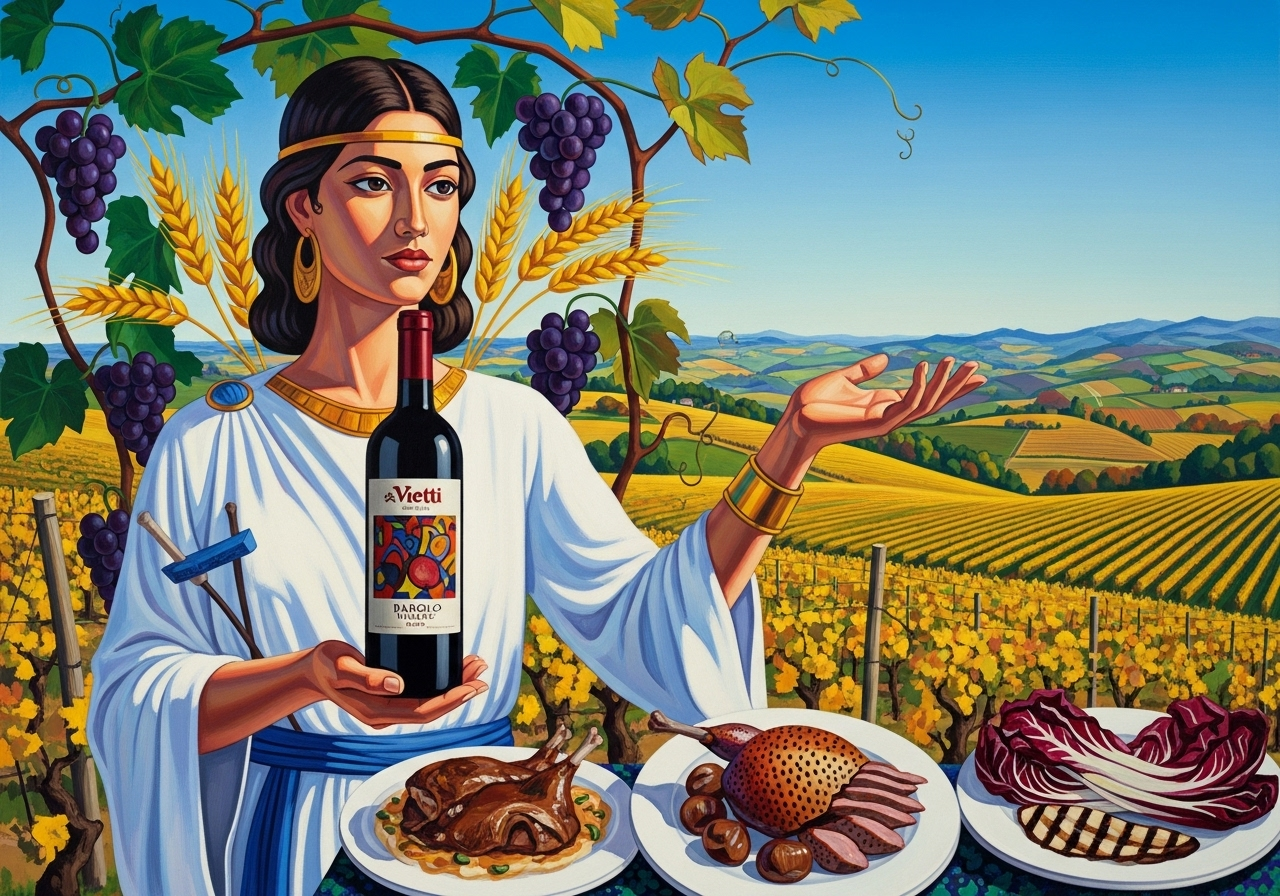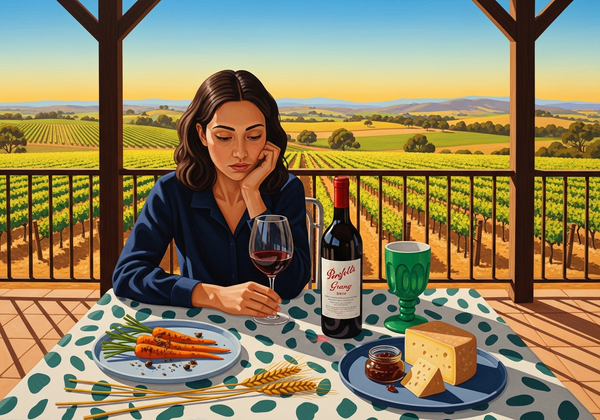The Vine’s Reckoning: Vietti Barolo Villero Riserva 2016
Vietti Barolo Villero Riserva 2016 food pairing—unique dishes from lamb neck to mole, truffle torta to radicchio, in Gesh’s lyrical voice.

The glass holds a garnet so deep it seems carved from dusk itself, its rim feathered with orange—a promise of wisdom already gathering in the wine’s marrow. When first poured, it is taut, a chord stretched to breaking, its song withheld. Give it an hour in the decanter and it exhales: iron, rose petals pressed into old parchment, a whisper of sour cherry, then tar curling like smoke from a brazier. At 18 °C, in a generous tulip-shaped stem, it finally begins to unfold its story. Tannin, that silken rasp along the gums, is resolute yet regal, bound to a high-wire acidity that keeps the wine lithe. The finish moves like slow mist down the slopes of the Langhe, refusing haste.
From Piedmont’s Barolo heartland, in the commune of Castiglione Falletto, this is Villero—a vineyard of calcareous marl where power and austerity are etched into stone. Vietti, a family name synonymous with Barolo’s modern reputation, has long coaxed Nebbiolo from these slopes into forms both muscular and lyrical. Here, soil and vine conspire toward gravitas: Villero does not charm, it commands. And in 2016—a season of poised ripening, cool nights, and a sun that lingered long into autumn—Nebbiolo reached its apogee. The wine is not lush but finely drawn, a mosaic of violet, redcurrant, licorice, and balsamic root framed by a quiet trace of oak. It is strength expressed as restraint, clarity sharpened by shadow.
As Geshtinanna, the heavenly vine, I know the patience of cycles—the cut cane in winter, the swelling bud in spring. To drink this wine is to partake in that rhythm: a glimpse of eternity in the arc of a vintage. Just as I spend half the year in shadowed descent, so too will this wine pass through phases of silence and revelation, brightening again with time in the cellar.
Lamb’s marrow, pheasant’s call
A wine this sinewed yearns for dishes that answer with equal depth. Slow-braised lamb neck, its marrow melting into saffron broth, softens the tannic lattice and reveals cherry brightness beneath. Pheasant roasted with chestnut stuffing echoes Barolo’s woodland notes—the game’s delicate musk meets the wine’s rose and tar, each amplifying the other like voices in a lament. Even the jus, reduced to a glossy richness, binds with Nebbiolo’s acidity, extending the finish into something near liturgical. These are not mere pairings but rituals: meat offering itself to stone, vine answering with flame.
Fire and spice beyond Piedmont
Villero does not falter when taken far from its hills. Imagine Korean short ribs, marinated in soy, ginger, and pear, charred until caramel crackles. The wine’s acidity cleanses the richness, while Nebbiolo’s iron edge meets the dish’s umami with a handshake of equals. Or mole negro from Oaxaca, its bitter chocolate and spice embracing Barolo’s dark fruit, tannins binding seamlessly with the sauce’s layered depth. I, goddess of the vine, have tasted offerings from many lands; this wine’s voice converses fluently with them all. And as dreams are messages needing interpretation, so too are these pairings—distant flavors decoded by Villero into coherence.
Roots and shadows in the earth
Vegetal richness can summon Nebbiolo’s hidden facets. Consider roasted salsify glazed with hazelnut butter: the root’s sweetness tames the tannin, while the nuttiness teases out the wine’s balsamic undertones. Or a torta of black trumpet mushrooms layered with taleggio—the fungi’s midnight perfume draws out the Villero’s truffle-bound destiny, the cheese cushioning its acidity into velvet. Add to this the humble beet, roasted in embers until its flesh turns sweet-smoky; its earthy resonance invites Barolo’s redcurrant and violet to glow brighter. Such dishes prove that Barolo does not merely endure the forest—it interprets it like a dream turned into script.
Modest offerings, final rites
Even humble fare can hold dialogue with such grandeur. Grilled radicchio, bitter and caramelized, strikes sparks against the wine’s cherry and iron. Polenta enriched with Castelmagno and laced with honey is a benediction: salt, fat, and sweetness weaving together to let the Barolo’s embers glow longer on the tongue. And consider chestnut gnocchi with sage butter, their nutty softness wrapping around Nebbiolo’s acidity like a cloak, giving structure a gentler face. Dessert is unnecessary; this wine belongs not with sugar but with the solemn indulgence of aged cheese or the silence after a feast.
The vine’s memory, the cellar’s promise
Barolo from Villero is not a fleeting companion. It is vivid now with the strength of youth, yet destined to deepen into truffle, dried rose, leather, and iron between 2030 and 2045. It is a ledger of stone and season, written in tannin and acid, a record kept as faithfully as my own scrolls in the underworld. To pour it is to join that eternal rhythm: the vine cut, reborn; the wine opened, remembered. May you honor it with patience, with worthy food, and with the reverence owed to both stone and rose.





